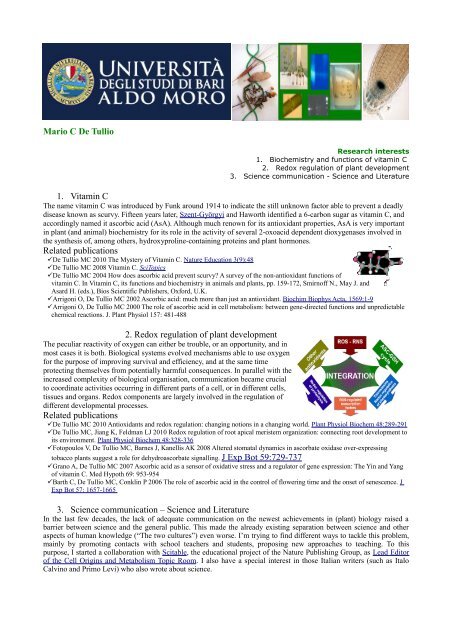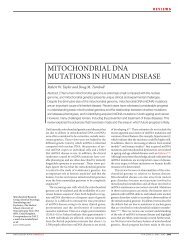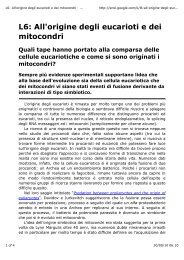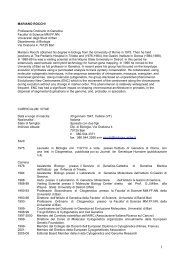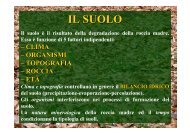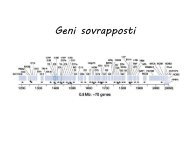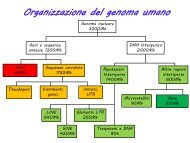Mario C De Tullio 1. Vitamin C Related publications 2. Redox ...
Mario C De Tullio 1. Vitamin C Related publications 2. Redox ...
Mario C De Tullio 1. Vitamin C Related publications 2. Redox ...
Create successful ePaper yourself
Turn your PDF publications into a flip-book with our unique Google optimized e-Paper software.
<strong>Mario</strong> C <strong>De</strong> <strong>Tullio</strong><br />
Research interests<br />
<strong>1.</strong> Biochemistry and functions of vitamin C<br />
<strong>2.</strong> <strong>Redox</strong> regulation of plant development<br />
3. Science communication - Science and Literature<br />
<strong>1.</strong> <strong>Vitamin</strong> C<br />
The name vitamin C was introduced by Funk around 1914 to indicate the still unknown factor able to prevent a deadly<br />
disease known as scurvy. Fifteen years later, Szent-Györgyi and Haworth identified a 6-carbon sugar as vitamin C, and<br />
accordingly named it ascorbic acid (AsA). Although much renown for its antioxidant properties, AsA is very important<br />
in plant (and animal) biochemistry for its role in the activity of several 2-oxoacid dependent dioxygenases involved in<br />
the synthesis of, among others, hydroxyproline-containing proteins and plant hormones.<br />
<strong>Related</strong> <strong>publications</strong><br />
<strong>De</strong> <strong>Tullio</strong> MC 2010 The Mystery of <strong>Vitamin</strong> C. Nature Education 3(9):48<br />
<strong>De</strong> <strong>Tullio</strong> MC 2008 <strong>Vitamin</strong> C. SciTopics<br />
<strong>De</strong> <strong>Tullio</strong> MC 2004 How does ascorbic acid prevent scurvy? A survey of the non-antioxidant functions of<br />
vitamin C. In <strong>Vitamin</strong> C, its functions and biochemistry in animals and plants, pp. 159-172, Smirnoff N., May J. and<br />
Asard H. (eds.), Bios Scientific Publishers, Oxford, U.K.<br />
Arrigoni O, <strong>De</strong> <strong>Tullio</strong> MC 2002 Ascorbic acid: much more than just an antioxidant. Biochim Biophys Acta, 1569:1-9<br />
Arrigoni O, <strong>De</strong> <strong>Tullio</strong> MC 2000 The role of ascorbic acid in cell metabolism: between gene-directed functions and unpredictable<br />
chemical reactions. J. Plant Physiol 157: 481-488<br />
<strong>2.</strong> <strong>Redox</strong> regulation of plant development<br />
The peculiar reactivity of oxygen can either be trouble, or an opportunity, and in<br />
most cases it is both. Biological systems evolved mechanisms able to use oxygen<br />
for the purpose of improving survival and efficiency, and at the same time<br />
protecting themselves from potentially harmful consequences. In parallel with the<br />
increased complexity of biological organisation, communication became crucial<br />
to coordinate activities occurring in different parts of a cell, or in different cells,<br />
tissues and organs. <strong>Redox</strong> components are largely involved in the regulation of<br />
different developmental processes.<br />
<strong>Related</strong> <strong>publications</strong><br />
<strong>De</strong> <strong>Tullio</strong> MC 2010 Antioxidants and redox regulation: changing notions in a changing world. Plant Physiol Biochem 48:289-291<br />
<strong>De</strong> <strong>Tullio</strong> MC, Jiang K, Feldman LJ 2010 <strong>Redox</strong> regulation of root apical meristem organization: connecting root development to<br />
its environment. Plant Physiol Biochem 48:328-336<br />
Fotopoulos V, <strong>De</strong> <strong>Tullio</strong> MC, Barnes J, Kanellis AK 2008 Altered stomatal dynamics in ascorbate oxidase over-expressing<br />
tobacco plants suggest a role for dehydroascorbate signalling. J Exp Bot 59:729-737<br />
Grano A, <strong>De</strong> <strong>Tullio</strong> MC 2007 Ascorbic acid as a sensor of oxidative stress and a regulator of gene expression: The Yin and Yang<br />
of vitamin C. Med Hypoth 69: 953-954<br />
Barth C, <strong>De</strong> <strong>Tullio</strong> MC, Conklin P 2006 The role of ascorbic acid in the control of flowering time and the onset of senescence. J<br />
Exp Bot 57: 1657-1665<br />
3. Science communication – Science and Literature<br />
In the last few decades, the lack of adequate communication on the newest achievements in (plant) biology raised a<br />
barrier between science and the general public. This made the already existing separation between science and other<br />
aspects of human knowledge (“The two cultures”) even worse. I’m trying to find different ways to tackle this problem,<br />
mainly by promoting contacts with school teachers and students, proposing new approaches to teaching. To this<br />
purpose, I started a collaboration with Scitable, the educational project of the Nature Publishing Group, as Lead Editor<br />
of the Cell Origins and Metabolism Topic Room. I also have a special interest in those Italian writers (such as Italo<br />
Calvino and Primo Levi) who also wrote about science.
<strong>Related</strong> <strong>publications</strong><br />
- <strong>De</strong> <strong>Tullio</strong> MC, 2011, GMOs, Primo Levi, ivory towers and communication. VIPCA Meeting “Plant Transformation Technologies<br />
II”, Vienna, Austria<br />
- <strong>De</strong> <strong>Tullio</strong> MC 2007 How literature can help science: a practical approach to bridging the Two Cultures. Plant Biology ASPB<br />
Meeting Chicago (IL, USA)<br />
- <strong>De</strong> <strong>Tullio</strong> MC, Roberto R 2004 Informing the public on the risks and benefits of plant biotechnologies: the role of teacher training<br />
and the importance of new teaching tools. Plant Biology, ASPB Meeting , Orlando (FL, USA)<br />
- <strong>De</strong> <strong>Tullio</strong> MC (2002) Disseminating plant biology: how and what for? FESPB alert n.2 (9)


